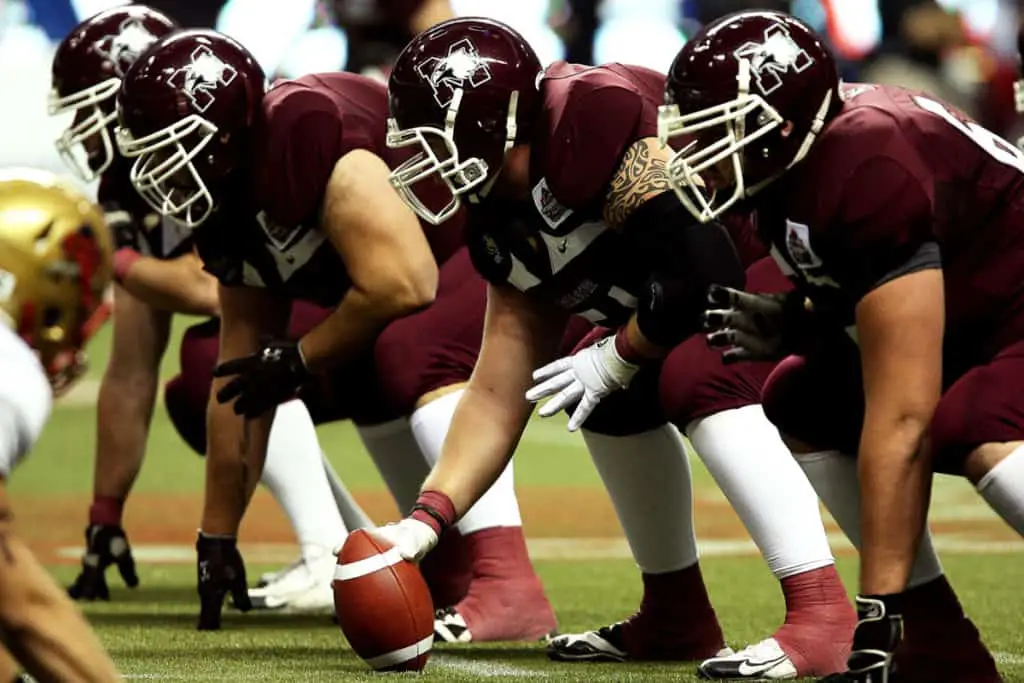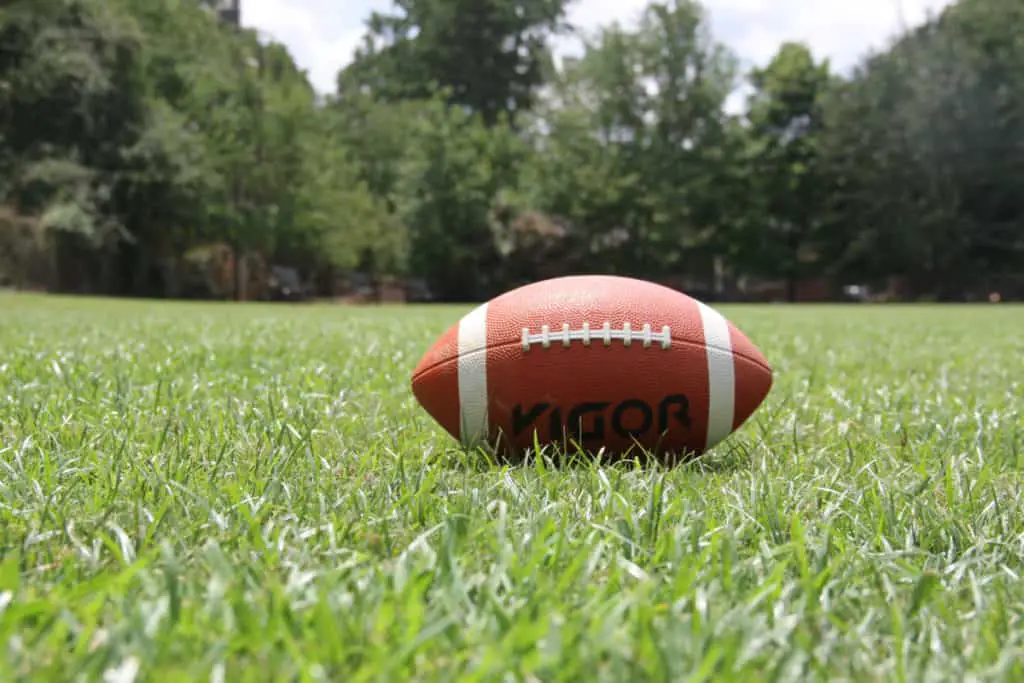Football is a game that requires some physical features, some athleticism, and some knowledge of the game. The best part about football, however, is that the range of sizes does vary.
There are smaller players and bigger players that play football and sometimes being shorter can be an advantage for some positions.
The average heights and weights does vary based on the role and position on the football field. There is a place for all sizes, and in this article we will discuss those requirements, and talk about the positions individually.

How Big do I Need to be to Play Football?
There is no required size to play football. If you love the game of football, there is a position that you can play. There are advantages and disadvantages to different sizes on the football field and this is dependent mostly on the position and role.
In this article we will discuss the advantages and disadvantages based on height and weight for multiple positions.
Youth Football
Youth football is great in the fact that many different body types can play. At the younger ages, the requirements for each position is not as important as the higher levels of football.
Youth of all ages can find themselves playing multiple positions on the football field. Being taller or heavier can be an advantage for some positions, but in youth football size isn’t as important.
At the youth levels, size seems to be of less importance. We have found that some of the best offensive linemen are not necessarily the biggest kids. Some kids seem to grasp this position quicker than others. Having quick feet, for example, can sometimes make up for a lack of size.
High School Football
Once high school level football is being played, size does become a little more important, but still not as important as the levels above high school
We tend to see that kids that are a little less in weight tend to play more of the skilled positions, such as quarterback, wide receiver, and defensive back. This is always the case, as we do see some bigger sized kids playing these skilled positions at times.
Smaller type players can still find themselves on the field, playing positions like wide receiver, running back, or defensive back.
Larger high school players tend to find themselves on the offensive or defensive lines, but this is not always the case.
College Football
This level is even more demanding, and the opportunities for playing based on size tend to get narrowed down. We see that there are typical sizes for particular positions at the college level, mostly based on speed and strength.
National Football League
In the NFL, size does matter, and we do not see as many outliers. There are some, however, but usually it is smaller players playing the line positions, versus the other way around.
These players are being paid, and those running these organizations tend to stick with the numbers and data that is presented.
We will discuss different positions and how size affects these positions, based on the NFL:
Quarterbacks
The heights and weights of NFL quarterbacks does vary, but on average, quarterbacks stand at 6 feet, 3 inches tall. This does seem rather tall, considering the average man stands at 5 feet, 9 inches.
Height in the NFL for quarterbacks can play an important role. Quarterbacks need to be able to see over the line of scrimmage, so being tall is an advantage.
The average weight of an NFL quarterback is 225 pounds. This number has increased over the years.
Who is the Shortest Quarterback in the NFL?
The shortest NFL quarterback in today’s game is Kyler Murray. Murray stands at 5 feet, 10 inches, which is still taller than an average man.
This quarterback possesses a lot of quickness, and has a very high football IQ, allowing him to play at a shorter height than most quarterbacks in the NFL.
Who is the Tallest Quarterback in the NFL?
Mike Glennon, who plays for the New York Giants, is the tallest quarterback in the NFL. Glennon stands at 6 feet, 7 inches.
Offensive Linemen
This position does vary as well, however, being big and tall in the NFL is extremely important. The average height of an offensive lineman in the NFL is 6 feet, 5 inches tall.
This average height for offensive linemen has changed dramatically in recent years. In the NFL, 25 years ago, we didn’t see linemen that tall. This has almost become a standard nowadays.
The average weight of offensive linemen in the NFL is 314 pounds. This also has changed over the years, mostly due to new lifting ideas and science. 314 pounds is a lot of weight, but most of the offensive linemen can move very quickly.
Who is the Biggest Offensive Linemen in the NFL?
Trent Brown, of the Las Vegas Raiders, is the largest player in the NFL. Brown is 6 feet, 8 inches tall, and weighs 380 pounds. Brown is an offensive lineman, who has played for several teams.
Running Backs
The running back position is a tough position because it requires some size, but a great deal of speed as well. Running backs need to maintain strength, but also maintain speed.
Running backs at the professional level are players that are extremely athletic and can perform a great deal of skills, but also need to have an amount of strength as well.
The average running back in the NFL is 6 feet tall and roughly 215 pounds. This fine line of strength, bulk, and speed can be difficult to find. Big running backs that are also fast are very rare.
Who is the Biggest Running Back in the NFL?
Derrick Henry is the biggest running back in the NFL. Henry is 6 feet, 3 inches, and weighs 247 pounds.
Derrick Henry is a prime example of a big player who is extremely athletic. Henry tends to lead the league many years and is considered one of the best running backs to ever play the game. His size is rare, because he is a perfect combination of size, strength, and speed.
Wide Receivers
Wide receivers vary greatly in size, depending on their role on their team. We see that some of the quickest players in the NFL are wide receivers, but some are small compared to others.
This position can take on a variety of sizes, but similar to running backs, the best receivers are tall, but fast and athletic as well.
Wide receivers must possess the ability to catch the football, but also use their strength to block for running backs and others who carry the football.
The average wide receiver in the NFL is 6 feet, and 200 pounds. There are some outliers to this, but for the most part, wide receivers tend to be a little less in weight than running backs.
Smallest Wide Receiver in NFL
Trindon Holliday is the smallest wide receiver in the NFL. Holliday is 5 feet, 5 inches and weighs 165 pounds. Holliday is the smallest player in the NFL, but is also one of the fastest players in the NFL.
Holliday, although small, has other attributes that somewhat defy the normal. Holliday is fast and has great hands and has been an effective player thus far in the NFL.
Defensive Linemen
Defensive linemen in the NFL are some of the biggest players on the field. Their job is to stop opposing offenses, and size is important. Defensive linemen are some of the strongest players on a football team.
Defensive linemen need strength, size, and some speed.
Linebackers
Linebackers are a rare breed in the NFL, as they are involved in a great deal of contact. The physicality requirements are vast, so size and strength is an important attribute.
The average linebacker in the NFL is 6 feet tall and around 245 pounds. These players are big but also strong and must be able to run.
Defensive Backs
The average defensive back in the NFL is 5 feet, 11 inches and 195 pounds. The defensive backs in the NFL are some of the best athletes on a football field. These players have to be athletic and quick.
Defensive backs also need to change directions quickly, so being overweight is not a great attribute. Defensive backs also need to be able to tackle in space, which requires some strength as well.

What Position Should I Play in Football?
Based on size and skill, picking a position in football can be challenging. Size does matter, but is not as important at younger ages and lower levels of football.
For more information read this article:
Final Thoughts
Choosing a position to play in football can be a task that is not easy to do. The average size, based on weight and height have been discussed above, but at lower levels of football, these averages are not a necessary requirement for success.
The skills, such as, speed, strength, and athletic ability end up playing more of a role at the lower levels than does the size of the person.
